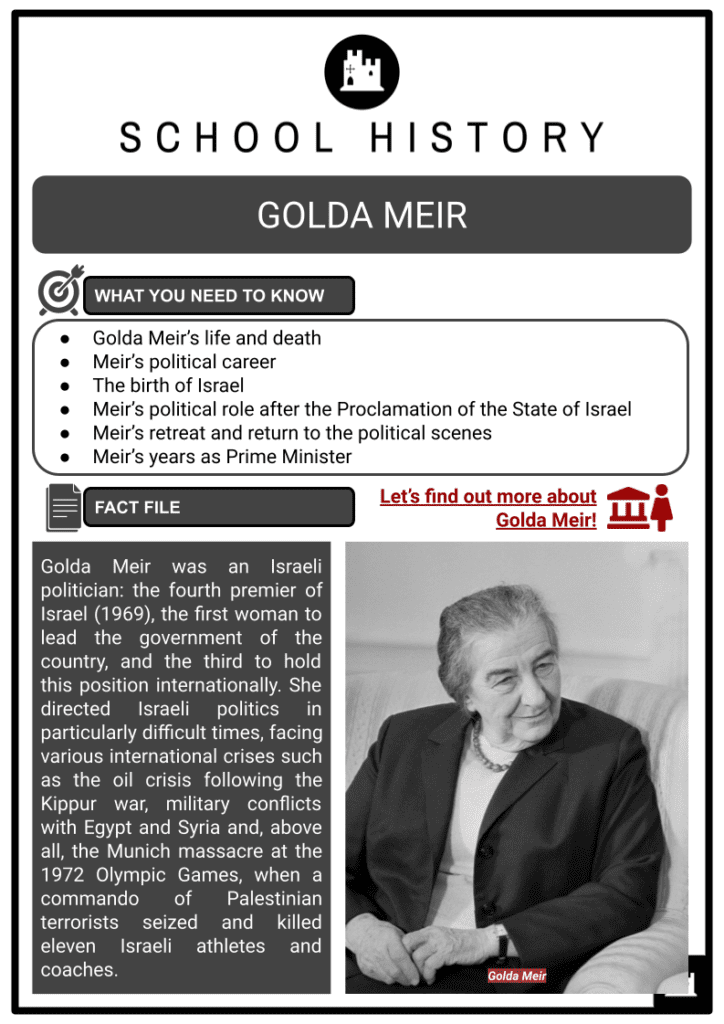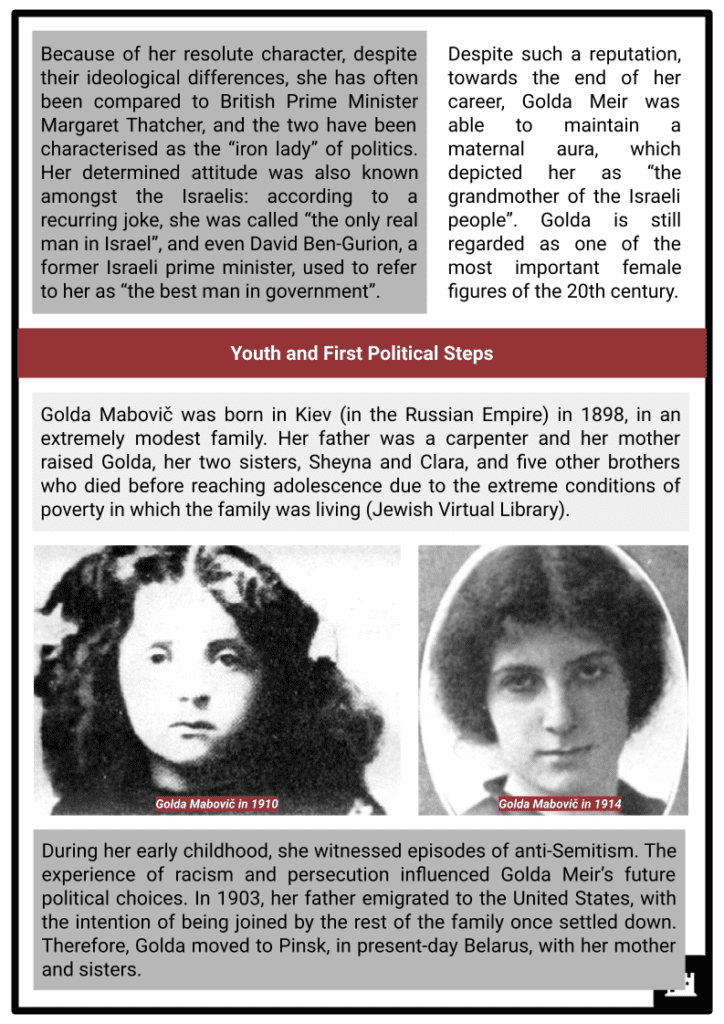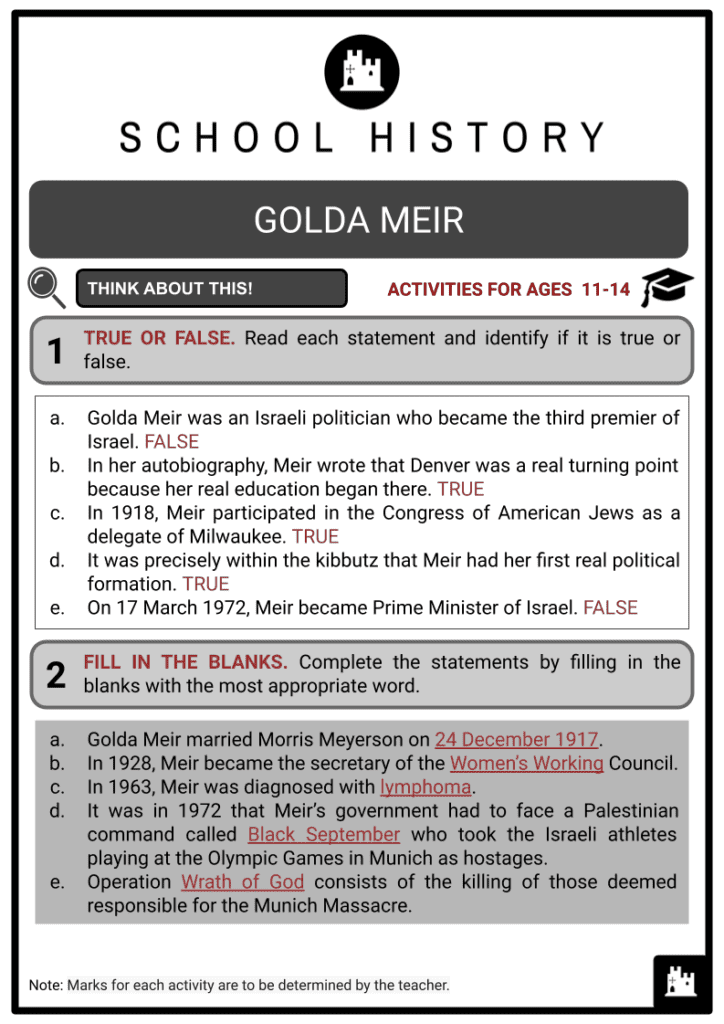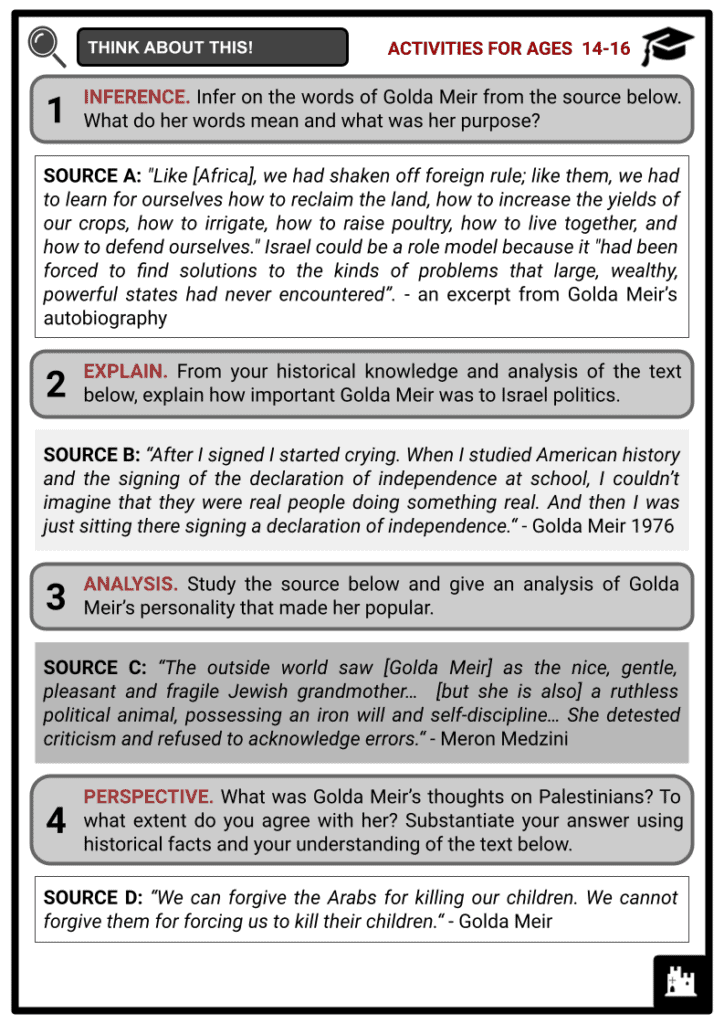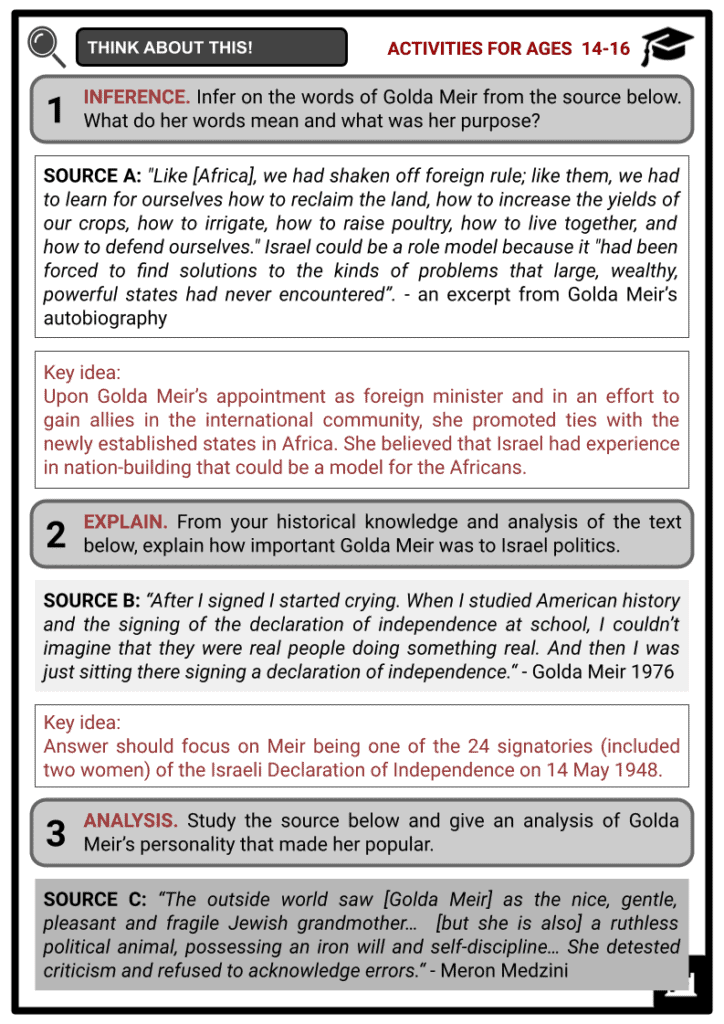Download Golda Meir
Do you want to save dozens of hours in time? Get your evenings and weekends back? Be able to teach about Golda Meir to your students?
Our worksheet bundle includes a fact file and printable worksheets and student activities. Perfect for both the classroom and homeschooling!
Table of Contents
Add a header to begin generating the table of contents
Summary
- Golda Meir’s life and death
- Meir’s political career
- The birth of Israel
- Meir’s political role after the Proclamation of the State of Israel
- Meir’s retreat and return to the political scenes
- Meir’s years as Prime Minister
Key Facts And Information
Let’s find out more about Golda Meir!
- Golda Meir was an Israeli politician: the fourth premier of Israel (1969), the first woman to lead the government of the country, and the third to hold this position internationally. She directed Israeli politics in particularly difficult times, facing various international crises such as the oil crisis following the Kippur war, military conflicts with Egypt and Syria and, above all, the Munich massacre at the 1972 Olympic Games, when a commando of Palestinian terrorists seized and killed eleven Israeli athletes and coaches.
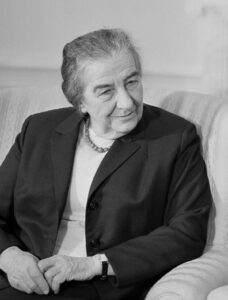
- Because of her resolute character, despite their ideological differences, she has often been compared to British Prime Minister Margaret Thatcher, and the two have been characterised as the “iron lady” of politics. Her determined attitude was also known amongst the Israelis: according to a recurring joke, she was called “the only real man in Israel”, and even David Ben-Gurion, a former Israeli prime minister, used to refer to her as “the best man in government”.
- Despite such a reputation, towards the end of her career, Golda Meir was able to maintain a maternal aura, which depicted her as “the grandmother of the Israeli people”. Golda is still regarded as one of the most important female figures of the 20th century.
Youth and First Political Steps
- Golda Mabovič was born in Kiev (in the Russian Empire) in 1898, in an extremely modest family. Her father was a carpenter and her mother raised Golda, her two sisters, Sheyna and Clara, and five other brothers who died before reaching adolescence due to the extreme conditions of poverty in which the family was living (Jewish Virtual Library).
- During her early childhood, she witnessed episodes of anti-Semitism. The experience of racism and persecution influenced Golda Meir’s future political choices. In 1903, her father emigrated to the United States, with the intention of being joined by the rest of the family once settled down. Therefore, Golda moved to Pinsk, in present-day Belarus, with her mother and sisters.
- She reached her father in Milwaukee (Wisconsin) in 1906, and she completed her first school cycle in the United States, at the Fourth Street Grade School (now renamed the Golda Meir School in her honour). Although she did not speak English, since her early school years, Meir demonstrated strong leadership skills, promoting many initiatives, including fundraising for the purchase of books and text for less well-off comrades.
- After arguing with her parents, who wanted to force her to leave her studies as a teacher in order to get married, at the age of 14, Golda Meir moved to Denver, Colorado, to her sister’s house. Her sister and her sister’s husband organised cultural debates, and thanks to those events, Meir came into contact with the literary world, feminism, and the Zionist ideology. She wrote in her autobiography that Denver was a real turning point because her real education began there (Meir 1976).
- Here, in 1913, Meir met Morris Meyerson, and she married him on 24 December 1917, at the age of 19, immediately after obtaining American citizenship. After graduating in 1916, she enrolled at university, the Milwaukee Normal School, and subsequently became a teacher. Golda taught at a Yiddish school in Milwaukee. She participated and organised protest marches, and became a member of the Labour Zionist organisation Poalei Zion.
- In the following two years, her political commitment in Jewish and Zionist associations was very intense and allowed her to travel across the United States. In 1918, she participated in the Congress of American Jews as a delegate of Milwaukee. Golda was the youngest delegate of the meeting, and this marked the beginning of her political career (Meir 1976).
Political Career and the Birth of Israel
- Despite her husband’s reservations, in 1921, the couple left America to move to Palestine along with her sister Sheyna and her sister's daughter. The group reached Tel Aviv. Upon their arrival in Jewish Palestine, the Meyerson joined a kibbutz, despite the initial distrust of the other members due to the couple’s nationality (both were American citizens).
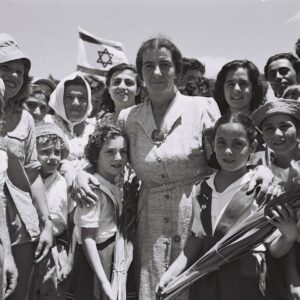
- It was precisely within the kibbutz that Meir had her first real political formation. After three years in the kibbutz, in 1924, the family (following the birth of their first child, Menahem, and Morris’s illness) decided to move to Jerusalem. Here, Meir found employment as treasurer at the General Office of the Federation of Workers of the Territories of Israel, one of the most important Israeli economic organisations.
- In 1928, she became the secretary of the Women’s Working Council, while in 1930, she joined the Mapai Party (the Israeli workers’ party), which later merged with the Labour Party.
- In 1946, Golda was at the head of the political department of the Jewish Agency for Palestine. Meanwhile, she began to actively engage in Zionist political activities, becoming a delegate of the World Zionist Organisation and organising the illegal immigration of Jewish refugees from Europe to Palestine during World War II.
- At the end of the Second World War, Meir was mainly concerned with the institutionalisation of the State of Israel in the Holy Land. At the beginning of 1948, she returned to the United States in order to raise funds for Palestine, so when Israel’s independence was proclaimed on 14 May 1948, Golda Meir became a member of the Provisional Council of State. She was one of two women signatories, out of twenty-four, for the declaration of Independence of Israel.
Political Role after the Proclamation of the State of Israel
- After the proclamation of the State of Israel, and the end of the hostilities of the first Arab Israeli conflict, Golda Meir became the first ambassador for the newly formed State of Israel in Moscow.
- In 1949, she became part of the Israeli parliament. The then Prime Minister David Ben-Gurion proposed her as Deputy Prime Minister, a role which Meir declined, preferring to opt for the ministry of labour. Despite her experience and political commitment shown during the years of the kibbutz, Golda Meir had to overcome the hostility of many Labourists who considered it risky to have a woman in the ministry of labour.
- Despite criticism, Meir worked hard to resolve social security problems, particularly, the allocation of homes and jobs. The following year, Morris Meyerson died of a heart attack. Although the two lived apart for years, Meir did not fail to travel to Tel Aviv for her husband’s funeral.
- In 1955, Meir was a candidate for the position of mayor of Tel Aviv. However, she was not elected. At that time, Golda Jewishised her surname in Meir which signifies “enlightened”. Golda was reluctant to make such a change to her surname and decided to keep it as similar as possible to that of her deceased husband, Meyerson.
- In 1956, Golda Meir was appointed foreign minister and faced the Suez crisis. In a correspondence between Meir and the Polish political authorities, the future Israeli prime minister advanced the possibility of not allowing entry into Israel to elderly or handicapped Jews.
- Previously, selections were made on the basis of the immigrants’ professions. With the Law of Return (1950), Israel opened its borders to all the Jews of the world, guaranteeing them citizenship. However, in 1951, the law underwent some changes, favouring Jews who were at risk in their country of origin or who could pay for their own travel expenses (preferably if they were young, healthy and with a commercial activity) (Adwan et al. 2012).
Meir’s Retreat and Her Return to the Political Scenes
- In 1963, she was diagnosed with lymphoma and Meir thought about retiring from the political scene. In 1966, tired and sick, she resigned as a foreign minister; however, she maintained her seat at the Knesset. Yet, her retirement was short-lived: a few months later, she became the general secretary and united the three Labour groups: the Mapai party, the Ahdut Ha Avodah and the Rafi Party, into one single Labour Party.
- Meir decided once again to abandon the political scene. However, the sudden death of Levi Eshkol and the search for a successor risked causing a split within the newly formed Labour party. Meir was elected president of the Labour Party, and on 17 March 1969, she became Prime Minister of Israel. Golda Meir, the fourth person to hold the position of prime minister, remained in office for five years.
Years as Prime Minister and Death
- Golda Meir was the first woman to hold the main political office of the State of Israel. She decided to maintain the policies of Eshkol’s government. As a prime minister, Meir formed excellent relations with the United States, in particular with President Nixon (despite mutual personal antipathy) and with the American Jewish community, the largest in the world. She strongly encouraged the immigration of Jews to the land of Israel.
- It was in 1972 that Meir’s government had to face the biggest crisis: a Palestinian command called ‘Black September’ took the Israeli athletes playing at the Olympic Games in Munich as hostages, demanding the release of Palestinian political prisoners. The blackmail had no effect on Meir, who maintained her firmness. Due to the German federal police’s improvised blitz, all the hostages and five of the eight terrorists lost their lives. This event is now known as the Munich Massacre.
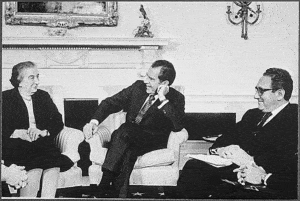
- Following the massacre, Meir’s government secretly began a repressive policy aimed at all the groups suspected of being in contact with ‘Black September’. Operation ‘Wrath of God’ consists of the killing of those deemed responsible for the Munich Massacre.
- In 1973, Israel was attacked by Egypt and Syria, and before Israel won the Yom Kippur War, it lost a great number of human lives. Meir had not started the war: in fact, if Israel had attacked Egypt and Syria, then the country would have not been entitled to the United States’ decisive aid.
- In 1974, however, the political chaos following the Yom Kippur War did not seem to abate, and Golda, at 76 years old, decided to retire. Meir remained an important voice within the Labour Party while writing a fun and documented biography, ‘My Life’ (1976), published in Italy by Arnoldo Mondadori Editore. Golda Meir died in Jerusalem on 8 December 1978, after a twelve-year battle against leukaemia.
Timeline of Golda Meir’s Life
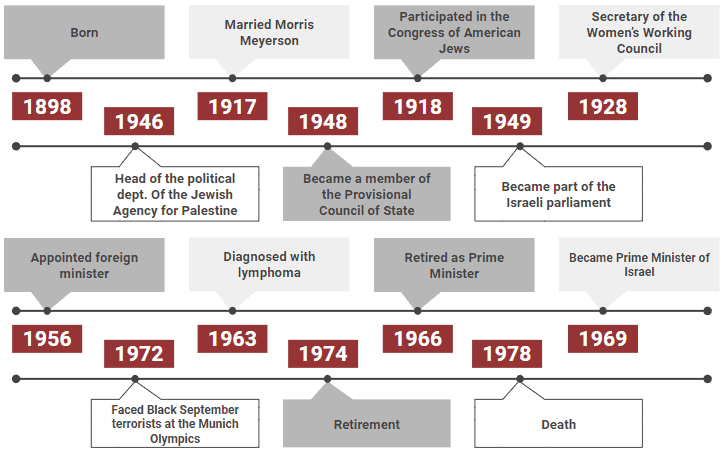
Image sources
- https://upload.wikimedia.org/wikipedia/commons/thumb/9/90/Golda_Meir_03265u.jpg/1200px-Golda_Meir_03265u.jpg
- https://upload.wikimedia.org/wikipedia/commons/4/4e/Golda_Meir_with_children_of_Kibbutz_Shfayim.jpg
- https://upload.wikimedia.org/wikipedia/commons/6/6f/President_Nixon%2C_Henry_Kissinger_and_Israeli_Prime_Minister_Golda_Meir%2C_meeting_in_the_Oval_Office_1973.gif

